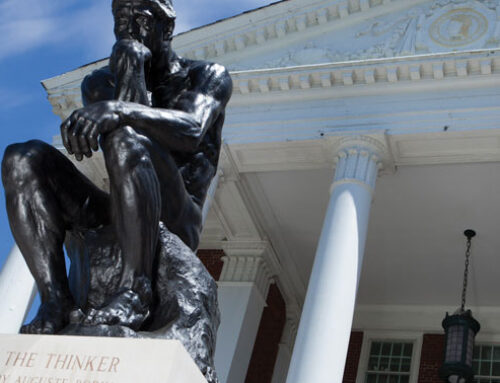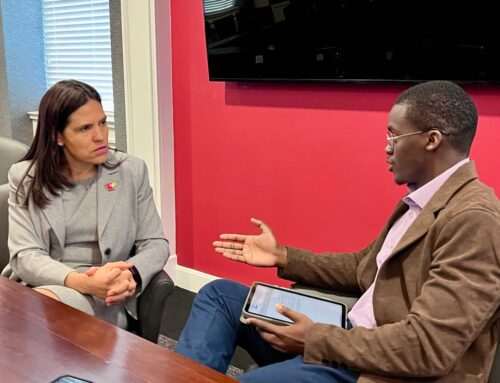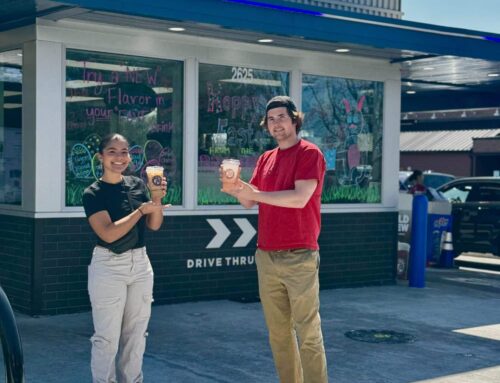By Ben Nance–
The Oscars are upon us once more and to show my disappointment with this year’s selection of nominees, I’ve composed a list of my 10 favorite picks from 2011. It’s ridiculous how many great movies came out this past year. I’ve never had this much fun–or difficulty–putting a list together. I had to cheat a little by including ties.
These are my 10 favorite movies of 2011:
10. Tie: “Moneyball” and “Martha Marcy May Marlene”
I’m a sucker for underdog stories, and this year had two great, emotionally cathartic sports movies centered on underdogs. One of them was “Moneyball.” I went into this movie with some trepidation, because like anyone else, I know baseball movies are kind of lame. Such was not the case here. “Moneyball” tells the true story of how two guys, played by Jonah Hill and Brad Pitt, practically revolutionized the sport with their ingenious drafting system based on number crunching. The dialogue is witty and air-tight – the best I’ve seen since last year’s “The Social Network.” This might be because both movies were scribed by Aaron Sorkin. His writing is so good it made me care about baseball statistics. If that isn’t movie magic, I don’t know what is.
“Martha Marcy May Marlene” was the best horror movie of the year, disguised as another woodland indie drama. The suspense is truly relentless, and I love it for that. I would be so bold to link it with films like “Deliverance,” “Straw Dogs” and “Rosemary’s Baby” in terms of how it conjures up real-life phobias of invasive lunatics with cult mentalities. Imagine your worst childhood nightmare where you are running from the boogieman – only instead of the boogieman, you are running from a murderous, guitar-strumming psychopath in the Catskills. Also, instead of a nightmare, it’s real life, so there is no waking up.
9. “Shame”
In case you haven’t heard of this one, it’s about a sex addict who, despite having a condition that comes off as laughable, has a seriously unhappy life. I can’t say I enjoyed “Shame” exactly. I found myself feeling emotionally drained and bothered when it was over. Still, I don’t feel like I can leave it off my list, mainly because it’s the only movie of 2011 that affected my mood days after I saw it. I don’t see that as a bad thing. I take notice when a movie has the ability to haunt, even if it isn’t “entertaining.” The horrifically depraved depths that “Shame” reaches is impressive, to say the least, and one can’t help but respect it for being so grounded in the constant stress of reality. The movie’s gut-wrenching final scenes were honestly painful to experience, but it was during those last fifteen minutes where the movie, to me, became great. Michael Fassbender conveyed Brandon’s personal hell with one hundred percent honesty and conviction. With this movie and 2008’s excellent “Hunger” under his belt, Fassbender and director Steve Mcqueen have proven to be an ideal filmmaking team. “Shame” was the most emotionally brutal drama of last year.
8. Tie: “Take Shelter” and “Warrior”
Michael Shannon plays Curtis, a man obsessed with expanding his backyard storm shelter. “Take Shelter” is a seriously entertaining drama that deals with heavy underlying topics ranging from schizophrenia to the apocalypse. Watching it for the first time is like watching two movies at once. In one movie you see the heartbreaking effects of a mentally deranged man trying to save his family from a catastrophic storm that exists only in his head. In the other movie you root for the same man in his struggle to make everyone realize the truth: that that he has been divinely chosen to act on his prophetic visions of doom. Which movie is real and which isn’t? You’ll have to wait and see the final shots to find out, and trust me, this one pays off. “Take Shelter” is a carefully constructed movie, building elements of horror, family drama and supernatural thriller up towards a shattering climax that had me gripping my theater armrest with Robocop-level strength. It has by far the greatest scene involving the unlocking of a storm shelter door that you will probably ever see.
And now for the second great sports movie: “Warrior.” This one’s about two estranged brothers who compete against each other in mixed martial arts–another arena, like baseball, that I wasn’t particularly invested in at first. The movie is deceptive in the way it takes its time. The first hour in, you’d think you’ve been watching an amazingly acted film adaptation of the show, “Intervention” with about five minutes of actual fighting. But man, that final hour is killer. Watch “Warrior” in a room with other people, because this is the kind of movie where everyone will be shouting, “Woah! Did you see that? This is crazy!” over each other as intensity of the bone-crunching fights dominates the screen. And once it finally gets around to the epically staged brother versus brother showdown, the entire room will be sobbing as the musical score transitions into The National’s “About Today.” It’s all very weepy and sentimental, but you know what? I don’t care. “Warrior” is the cathartic sports drama I so badly wanted “The Fighter” to be.
7. Tie: “Attack the Block” and “13 Assassins”
“Attack the Block” is a gift from British geniuses to you. It’s a fight to the death between hostile aliens and South London hoods armed with ninja weapons. If you aren’t running out to buy or rent this movie based on that premise description alone, you must not care much for being entertained. This movie hasrightfully been praised as the sci-fi experience “Super 8” should have been. Nothing against “Super 8,” which I liked, but that movie didn’t have an awesome slow-motion sequence where a horde of sharp-fanged, man-eating E.T’s chase a dude down an apartment stairwell while Basement Jaxx thumps loudly in the background. Scenes like these are what make the price of a movie ticket worthwhile. On top of giving you the urge to go alien hunting with your friends, “Attack the Block” will also introduce you to a lot of priceless British slang. I still find myself quoting the lines such as, “That’s an alien, bruv, believe it” and “Go home and play Fifa!”
Takashi Miike’s in-your-face killing spree “13 Assassins” is an exercise in controlled insanity. It raises the bar for all future action movies, as far as I’m concerned. Unlike most samurai epics, this one takes place in mid-19th century Japan, just as the era of the samurai is coming to a close. A group of rouge assassins must plot to kill a sociopathic ruler in order to prevent a new age of war. This leads to an amazing battle sequence that takes up the final 45 minutes of the movie. “13 Assassins” has “Kill Bill’s” massive scale of carnage, minus the red geyser anime physics. In other words, this is what would really go down if 13 guys with swords attacked 200 guys with swords. The movie’s meditative first half nicely contrasts the violent, yet immensely satisfying finale in which a remote village is ingeniously transformed into a death maze. I was particularly surprised by the extra attention given to character depth.

Don’t let the dreary title fool you. “Melancholia” is very urgent, like a giant luminous body of audacious imagination moving closer and closer to Earth. It follows the character of Justine, a newlywed whose depression defines her attitude as the world becomes threatened by an unstoppable cosmic force. “Melancholia” is by far my favorite work by director Lars von Trier, not because it boasts Kirsten Dunst’s finest performance to date, or because the painterly cinematography achieves sublime levels of Kubrik-ian detail. I say it’s my favorite for two reasons: I found the characters to be surprisingly compelling despite their emotionally cold personalities. For once, the people in a Lars von Trier universe felt human and tragic instead of ugly or misogynistic. The other reason is the movie’s intense shift from dinner party drama to end-of-the-world disaster scenario is brilliant. After sympathizing with the tortured soul of Justine during the first act, I literally felt panicked by the destructive indifference of the terrifying second act. It’s heavy stuff. “Melancholia” is a powerful work of art I like to think of as an anti-“Armageddon.”
5. “The Girl with the Dragon Tattoo”
I named “The Social Network” as my favorite film of 2010. That movie blew me away because it was such an inspired and perfect combination of story and direction. David Fincher was way out of his psychopathic-murderers-in-a-basement element, and I think because of that, he strived to make a better film. With “The Girl with the Dragon Tattoo,” he shows how eager he was to get back to his demented roots, and then some. I loved this movie because it was like a David Fincher greatest hits compilation. It had the cat-and-mouse intrigue of “Zodiac,” the dry humor of “Fight Club,” the suspense of “Panic Room,” the nihilism of “Seven” and just a pinch of the heart of “The Curios Case of Benjamin Button.” All of these trademark ingredients added up to an expertly crafted, perfectly paced piece of pulp entertainment. Rooney Mara blows up the screen with her amazing performance as Lisbeth Salander. Not giving her the Oscar would be madness. Despite its lengthiness, I never really wanted “The Girl with the Dragon Tattoo” to end. If it had kept going for another hour, I probably would have stayed in the theater. That “page-turner” quality from the Swedish novel translates seamlessly into this American film adaptation. I felt like I had come to the end of a dark, involving journey when the credits rolled, and that’s always exciting. Here’s to seeing two more sequels.
4. “The Artist”
You should not dismiss “The Artist” just because it has been fueled by the awards season hype machine. As much as I wanted to hate on it for being so universally adored, I can’t change the fact that the movie is a flat out masterpiece. Even if you are repelled by the lack of spoken dialogue, you cannot fault “The Artist” for a lack of devotion. The movie’s love for silent films is deeply genuine, and it completely avoids falling under the category of kitschy imitation. How exactly it pulled this off is beyond me. Since “The Artist” is a silent movie about silent movies, the audience is offered an historical context explaining why the format was so important. It does more than just entertain; it educates. The movie is proof that the human element supersedes any modern-day reliance on visual and audio perfection. I’m glad “The Artist” has gotten recognition from the Academy because it just as well could have been laughed at for its bravery. As a piece of pure cinema with its heart on its sleeve, “The Artist” won me over.
3. “Tinker Tailor Soldier Spy”
“Tinker Tailor Soldier Spy,” on top of being the third best movie I saw in 2011, is also the best spy movie I’ve ever seen, period. Every single one of its super-skilled actors gave a standout performance as if it was their last. Gary Oldman has never been better than in the role of George Smiley. Director Tomas Alfredson, to whom I will always be thankful for giving us “Let the Right One in,” proved he is a virtuoso at conjuring atmosphere by crafting a bona-fide piece of cinema for the senses. People — actors and directors mainly — always talk about wanting to emulate the style of 70s filmmaking, because it’s considered to be the golden age for movies. Forget emulation, “Tinker Tailor Soldier Spy” is a 70s film, not just because it’s a period piece, but because everything about it, from the hard-boiled ugliness of the characters to the narrative’s dark and hopeless path of moral confusion perfectly mirrors the defiant radicalism of classics like “The Conversation” and “Marathon Man.” A messy, yet highly calculated, beast belonging in its own category of awesome, “Tinker Tailor Soldier Spy” is a middle finger to anyone who wants their movies spoon fed to them. Didn’t like it because you were confused? I’m sorry to say it, but you missed the point.
2. “The Tree of Life”
I admit I was highly frustrated with “The Tree of Life” when I first saw it in theaters. I went in expecting a movie with a more traditionally structured narrative, and that’s why I came out disappointed. After several repeated viewings, however, my opinion has since shifted, and I now consider it to be one of my all-time favorites. A poem is not necessarily understood or felt completely in the first reading because there is so much to take in. This is something to consider before you watch this astoundingly beautiful film. “The Tree of Life” is exactly what it wants and needs to be: a philosophical meditation on human existence. It is filmed through the eyes of a distraught middle-aged man who tries to make sense of the world by contemplating its origins along with his own childhood memories. Since the movie is presented in this very personal fashion, the images and sounds elicit the feeling of a shared human experience. Every puzzling shot or jump cut is intended to get you involved in the film’s mysteries. You won’t get any answers because the point is to search for them yourself. The director, Terrence Malick, doesn’t pander to the expectations of a conventional moviegoer. “The Tree of Life” is not unlike “2001: A Space Odyssey.” If you watch it with an open mind, you will become transfixed by its grand ambitions.
1. “Drive”
The idea of “Drive” was based on the overly-stylized good vs. evil world of Grimm’s fairytales. This is why the movie appealed to my sensibilities in such a big way. It combined a ridiculously blissful, dream-like vision of shining goodness with sick, shocking moments of slaughter. Both light and dark were cranked up to their extremes, creating a tonal imbalance that was disturbing and yet oh-so perfect. It’s a delicious dichotomy, a perfect Reese’s Cup combination of flowers and guts. Ryan Gosling’s “Driver” is the white knight of the land, protecting the princess Irene from evil with his mean ultra violence. I loved how everything in the movie, no matter how mundane or minor, felt slightly unreal. The simple act of driving a Chevy Impala becomes something poetic. The seemingly familiar setting of LA is rendered strangely unfamiliar. I’ve never been to Los Angeles, but I suspect it is nothing like the city I saw in “Drive.” It’s as if movie was shot by an alien who tried to mimic a bland Hollywood blockbuster but failed and instead made a vivid fever-dream from another planet. While the inventive, jaw-dropping set pieces give off an oxygen-like high, the “I can’t believe this is happening” sensation never leaves, and you are left feeling exhilarated and unnerved when it’s over. The unforgettable scene where Driver fights two armed thugs in a motel is staged as if we were watching the woodsman hack away at the big bad wolves in a cabin. Where else but in the cinema can this kind of mad creativity be expressed? Without question, “Drive” was my favorite movie of 2011 because it reminded me why I love movies to begin with.
[email protected]
Photo:





